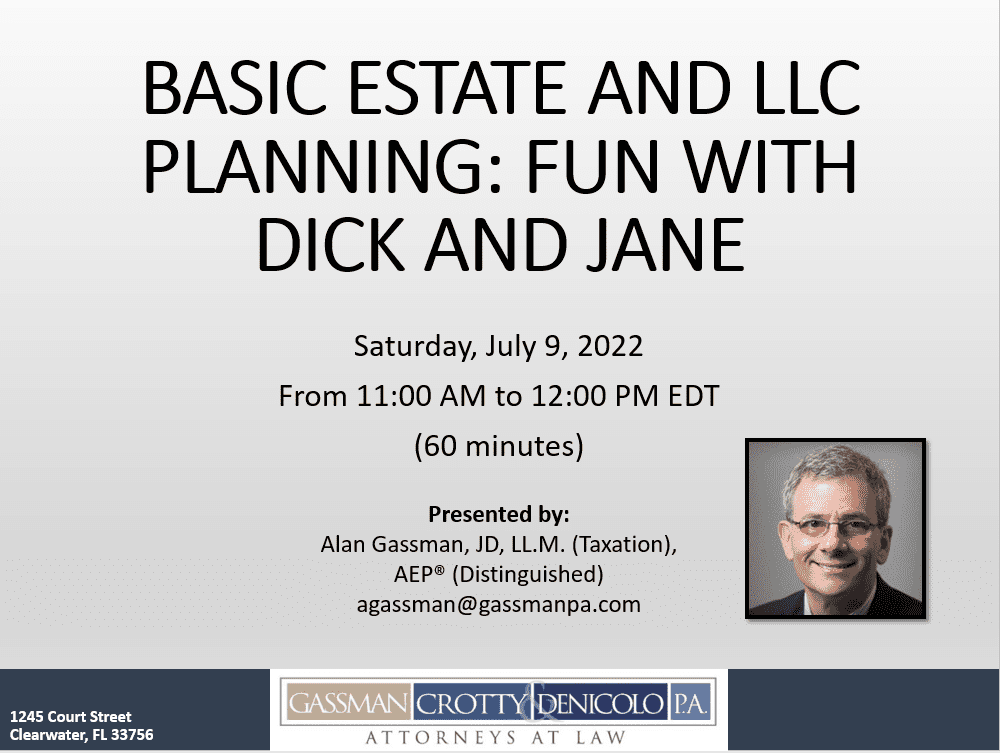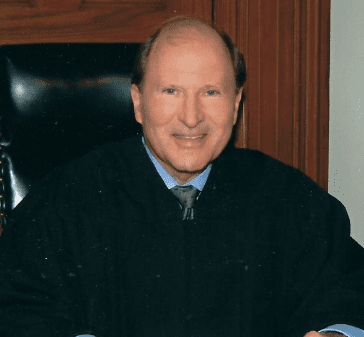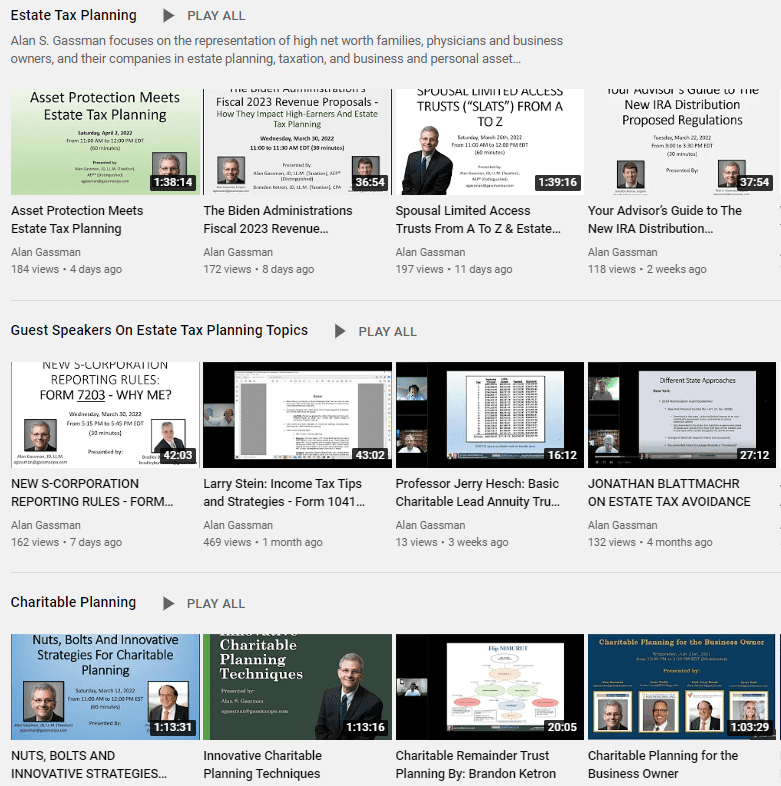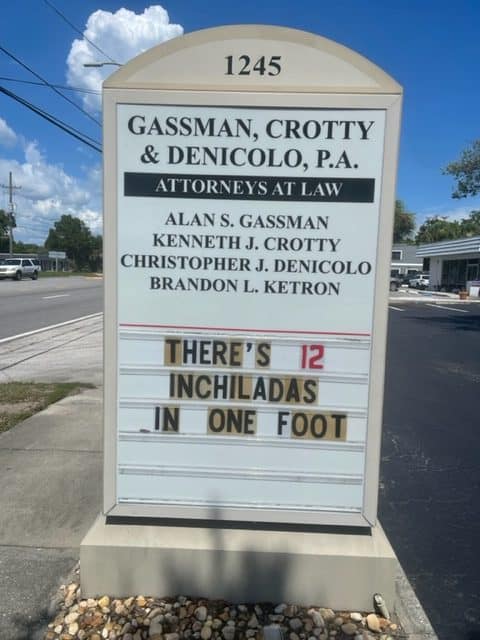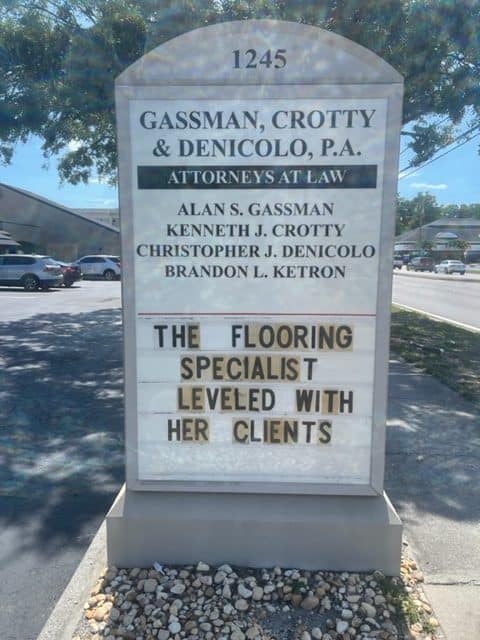The Thursday Report – Issue 327
|
|
|||||||||||||||||||||||||||||||||||||||||||||||||||||||||||||||||||||||||||||||||||||||||
|
|
|||||||||||||||||||||||||||||||||||||||||||||||||||||||||||||||||||||||||||||||||||||||||
|
|
|||||||||||||||||||||||||||||||||||||||||||||||||||||||||||||||||||||||||||||||||||||||||
|
Thursday, July 7th, 2022Issue #327Peter Piper Prepared this Pickled Publication
Coming from the Law Offices of Gassman, Denicolo & Ketron, P.A. in Clearwater, FL. Edited By: Wesley Dickson, Esquire Having trouble viewing this? Use this link
|
|||||||||||||||||||||||||||||||||||||||||||||||||||||||||||||||||||||||||||||||||||||||||
|
Please Note: Gassman, Crotty, & Denicolo, P.A. will be sending the Thursday Report out during the first week of every month. Article 1IRS Publishes Introduction to Incidental and Tenuous Exception to Self-dealing Under Treasury RegulationsWritten By: Alan Gassman, JD, LL.M. (Taxation), AEP® (Distinguished) Article 2Governor Vetoes “Kearney Patch” IRA Blanket UCC-1 Disqualification Bill – The Kearney Case is Permanent Law… For NowWritten By: Alan Gassman, JD, LL.M., & Brock Exline, Stetson Law Student Article 3IRS Issues Proposed Regulations for the Present Value of
|
|||||||||||||||||||||||||||||||||||||||||||||||||||||||||||||||||||||||||||||||||||||||||
|
Article 1IRS Publishes Introduction to Incidental and Tenuous Exception to Self-dealing Under Treasury RegulationsThe IRS is in a Precarious (and Pickled) Position
Written By: Alan Gassman, JD, LL.M., Peter Farrell, Stetson Law Student On June 29, 2022, the IRS published a non-precedential addition to its manual materials for auditors to discuss if and when monies spent from or transactions entered into between an individual taxpayer and an exempt private foundation will violate the self-dealing rules. The manual also indicates that a scholarship or fellowship grant to a non-disqualified person will not be an act of self-dealing when made by a private foundation “in accordance with a program to award scholarships or fellowship grants to the children of employees of a substantial contributor.” This new manual entry refers to Revenue Ruling 80-310, where “the grant by [a] private foundation to [a] university to establish an educational program in manufacturing engineering [did] not constitute an act of self-dealing” because “any benefit to the corporation, a disqualified person [was] incidental” and to Treasury Regulation § 53.4945-4(b)(5): Example 1: X company employs 100,000 people of whom 1,000 are classified by the company as executives. The company has organized the X company foundation which, as its sole activity, provides 100 4-year college scholarships per year for children of the company’s employees. Children of all employees (other than disqualified persons with respect to the foundation) who have worked for the X company for at least 2 years are eligible to apply for these scholarships. In previous years, the number of children eligible to apply for such scholarships has averaged 2,000 per year. Selection of scholarship recipients from among the applicants is made by three prominent educators, who have no connection (other than as members of the selection committee) with the company, the foundation or any of the employees of the company. The selections are made on the basis of the applicants’ prior academic performance, performance on certain tests designed to measure ability and aptitude for college work, and financial need. No disproportionate number of scholarships has been granted to relatives of executives of X company. Under these circumstances, the operation of the scholarship program by the X company foundation: (1) Is consistent with the existence of the foundation’s exempt status under section 501 (c) (3) [sic] and with the allowance of deductions under section 170 for contributions to the foundation; (2) Utilizes objective and nondiscriminatory criteria in selecting scholarship recipients from among the applicants; and (3) Utilizes a selection committee which appears likely to make objective and nondiscriminatory selections of grant recipients. The manual also references Revenue Ruling 77-331, which indicates that general reputation or prestige enhancement that is caused by public acknowledgment of donations is a relatively minor benefit “in the fruits of some charitable program that is of broad public interest to the community.” The manual entry states that a foundation can give its proxy for voting rights at an annual shareholder meeting to the subject company whose stock is being voted when the management of the company includes disqualified persons. The naming of a recreational center after a substantial contributor as a condition of a gift and a contribution by a private foundation to a public charity that requires the public charity to change its name to that of a substantial contributor for 100 years have been held by the IRS to not constitute self-dealing (example 4 of Treasury Regulation § 53.4941(d)-2(f)(9) and Revenue Ruling 73-407, 1973-2). The following “audit tips,” which an auditor who reviews a private foundation may use to detect self-dealing, are listed in the IRS’s update: Issue Indicators: • Review Form 990-PF, Return of Private Foundation or Section 4947(a)(1) Nonexempt Charitable Trust Treated as a Private Foundation, Part VI-B (Statements Regarding Activities for Which Form 4720 May Be Required) to determine whether there is any initial excise tax due under Section 4941. Audit Tips: • Review all transactions undertaken between the foundation and its disqualified persons. Examiners will need to investigate and identify the disqualified persons with respect to the private foundation and determine if any transactions have occurred between the disqualified persons and the foundation that might warrant further review. Evidence can be obtained from contracts, meeting minutes, bank statements and cancelled checks, interviews, tours of the facility, personnel and payroll records. |
|||||||||||||||||||||||||||||||||||||||||||||||||||||||||||||||||||||||||||||||||||||||||
|
Article 2Governor Vetoes “Kearney Patch” IRA Blanket UCC-1 Disqualification Bill – The Kearney Case is Permanent Law… For NowIs Peter Piper “Kearney” Patch on a Permanent Pause
Written By: Alan Gassman, JD, LL.M., & Brock Exline, Stetson Law Student
The November 13, 2019 decision of Kearney Construction Company, LLC v. Travelers Casualty and Surety Company of America, determined that a debtors’ personal IRA, which will normally be protected from creditors, is not protected and is instead liened if and when the IRA owner has completed a “Blanket” UCC-1 financing statement. A Blanket UCC-1 refers to a financing statement which grants a security interest to one or more lenders in “all assets of the debtor” or “all accounts.” The Kearney decision created much uncertainty regarding the use of boilerplate language in UCC-1’s of debtors who have a personal IRA, because Kearney indicated that such boilerplate language can result in disqualification of the IRA as a creditor protected asset, even after the creditor with the lien has been paid in full[1]. In the 2021 Florida Legislative Session, efforts were made to introduce a new bill that would fix the uncertainties created by the Kearney decision. Last year’s initial bill titled “Waivers of Exemptions of Applicable Assets,” spearheaded by Senator Lori Berman, unfortunately died in appropriations. At that time, however, the Tax Section of the Florida Bar indicated that they would look to put another iteration of the bill on the agenda in 2022. Senate Bill 406 was drafted to amend the current rules on description sufficiency when granting a security interest. The bill provided that a security agreement which granted a security interest in an IRA and only described the IRA by collateral type (i.e. accounts, deposit accounts, investment property, etc.) was insufficient so as to grant a valid security interest in the collateral. The bill would have fixed what has been considered an improper result for most IRA holders who may file a blanket UCC-1 due to the Kearney decision. Although the bill made it past the preliminary stages of this year’s legislative session, it was eventually vetoed by Governor Ron DeSantis on June 24, 2022. The Governor’s veto reads as follows: By the authority vested in me as Governor of the State of Florida, under the provisions of Article III, Section 8, of the Constitution of Florida, I do hereby veto and transmit my objection to Senate Bill 406 (SB 406), enacted during the 124th Session of the Legislature of Florida, during the Regular Session of 2022 and entitled: An act related to Secure Transactions. If SB 406 were to become law and be given retroactive effect as the Legislature intends, it would unconstitutionally impair certain vested rights and contracts. See art. I,§§ 9, 10, Fla. Const.[2] While the prospective policy reforms are sound, this does not cure the legal infirmities of the legislation. For this reason, I withhold my approval of Senate Bill 406 and do hereby veto the same.[3] This leaves thousands of Floridians who have given “Blanket UCC’s” over personal assets to creditors in a position where their IRAs may be subject to both: (1) Loss of creditor protection forevermore as to each IRA that existed at the time the Blanket UCC-1 was filed; and (2) Possible disallowance of the IRA at the time that the lien was given, causing taxable income to be recognized in an amount equal to the value of the IRA on that date, in addition to interest and penalties that could be applicable. A possible solution for IRA owners who have this issue may be to establish a new IRA, and transfer the assets from the IRA that was owned when the UCC-1 lien was granted to the new IRA as a “rollover” so that the new IRA has never been tainted by the lien, although it is not clear whether a legitimate new IRA funded in great part from an IRA that was or should have been disqualified will be treated the same as an IRA owned by an individual who has never had these issues. Fortunately, for many debtors, news and knowledge of the Kearney decision along with, the possible disqualification of their IRAs and the tax and creditor implications thereof, will never be known or recognized. However, in situations where creditors can easily see what UCC-1’s have historically been filed against an individual, such creditors may not only seize the IRA but also report the situation to the IRS, and the exposure may be significant. Another strategy would be to make withdrawals from the IRA and pay taxes thereon, or convert the IRA in whole or in part to a Roth IRA, so as to both: (1) Bear the tax burden sooner rather than later: and (2) Spend down the monies that come from the IRA, as opposed to converting them to another asset that a creditor may be able to seize. Assuming that the IRA is not protected because of the blanket UCC filing, this individual can withdraw all of his living expenses from the IRA that would otherwise have been exposed to existing creditors, while banking his or her paycheck into a low cost variable annuity contract or into tenancy by the entireties with a spouse that does not have an obligation to the same creditor or creditors in order to maximize asset protection planning without violating fraudulent transfer rules. The Governor’s veto indicates that he may be in agreement with the policy rationale behind the Kearney patch Bill. Perhaps a version of the bill which does not seek to give the law retroactive effect would pass muster and not be held to “impair certain vested rights and contracts.” In the meantime, and unless or until a Kearney patch bill is enacted, readers must be aware that the current state of Florida law continues to treat pledge agreements and security agreements which pledge all of an IRA holder’s “assets and rights, wherever located” as a pledge of IRAs, and possibly other tax-advantaged assets. As such, any security agreements should be closely reviewed and should carve out any tax-advantaged assets from being pledged under the agreement. A prudent debtor will pledge assets with great specificity. __________________________________________________________ [1] The specific language at issue in the security agreement in Kearney Construction Company, LLC v. Travelers Casualty and Surety Company of America 795 Fed. Appx. 671 (11th Cir. 2019)(unpublished) is as follows: “As security for any and all Indebtedness (as defined below), the Pledgor hereby irrevocably and unconditionally grants a security interest in the collateral described in the following properties[:] all assets and rights of the Pledgor, wherever located, whether now owned or hereafter acquired or arising, and all proceeds and products thereof, all goods (including inventory, equipment and any accessories thereto), instruments (including promissory notes), documents, accounts, chattel paper, deposit accounts, letters of credit, rights, securities and all other investment property, supporting obligation[s], any contract or contract rights or rights to the payment of money, insurance claims, and proceeds, and general intangibles.” [2] Article 1, Section 9 of the Florida Constitution provides: “No person shall be deprived of life, liberty or property without due process of law, or be twice put in jeopardy for the same offense, or be compelled in any criminal matter to be a witness against oneself.” Article 1, Section 10 of the Florida Constitution provides: “No bill of attainder, ex post facto law or law impairing the obligation of contracts shall be passed” [3] https://www.wqcs.org/2022-06-27/governor-vetoes-five-bills-and-signs-another-thirty-three-into-law
|
|||||||||||||||||||||||||||||||||||||||||||||||||||||||||||||||||||||||||||||||||||||||||
|
Article 3IRS Issues Proposed Regulations for the Present Value of
|
|||||||||||||||||||||||||||||||||||||||||||||||||||||||||||||||||||||||||||||||||||||||||
Article 4TBE, Your Paramour And MePeter Piper Picked a Paramour to Help Protect his Property
Written By: Alan Gassman, JD, LL.M., & Brock Exline, Stetson Law Student Florida Appellate Court Finds that Tenancy by the Entireties is not Destroyed by an Agreement Between Spouses that Requires Transfer of the Assets to an Irrevocable Trust on the First Death. Is the requirement that an asset must be held jointly with right of survivorship to be a tenancy by the entireties asset violated when a married couple enters into a binding agreement that requires the surviving spouse to transfer the assets to an irrevocable trust to benefit the surviving spouse and descendants? Can a constructive trust be imposed for quantum merit or detrimental reliance when a spouse inappropriately transfers tenancy by the entireties assets to a paramour in exchange for companionship services? Do people really have affairs with paramours and give them millions of dollars in assets in exchange for “love and affection”? [H]e wished to provide for her, to make her financially secure, and even comfortable. In exchange, she provided him her time, her companionship, and her intimate affection. She did not go to college and study for a career. She did not get a job and build up pension benefits and social security credits. She became Milton Wallace’s paramour.[2] The trial court concluded that the sacrifices made by the girlfriend (also known as the paramour) entitled her to keep some (approximately $1,700,000) of the assets that she had received based upon the doctrine of equitable estoppel (“detrimental reliance”) as recovery.[3] The Florida Third District Court of Appeal disagreed, holding that the trust assets conveyed to the girlfriend could be recouped. The assets that he transferred to the girlfriend were held in an irrevocable trust for the benefit of the spouses and the children of their marriage and the trust was supplemented by a marital agreement that prohibited either spouse from transferring joint marital assets while they were alive without “direct and personal joinder” of the other spouse.[4] The trial court imposed a constructive trust, which is “an equitable remedy in a situation where there is a wrongful taking in the property of another,” against some of the TBE assets that had been transferred to the girlfriend.[5] In the oft-cited Florida case of Quinn v. Phipps, the Florida Supreme Court accurately summarized the constructive trust doctrine as follows: A constructive trust is one raised by equity in respect of property which has been acquired by fraud, or where, though acquired originally without fraud, it is against equity that it should be retained by him who holds it. Constructive trusts arise purely by construction of equity, independently of any actual or presumed intention of the parties to create a trust, and are generally thrust on the trustee for the purpose of working out the remedy. They are said to arise from actual fraud, constructive fraud, and from some equitable principle independent of the existence of any fraud.[6] Under Florida law, to impose a constructive trust, a court must find clear and convincing proof of: (1) A promise, express or implied; (2) Transfer of the property and reliance thereon; (3) a confidential relationship; and (4) Unjust enrichment.[7] The appellate court agreed that a constructive trust was the proper remedy to recover TBE assets that were wrongfully transferred by one spouse during the marriage without the consent of the other spouse. However, the appellate court found that the detrimental reliance claim made by the paramour could not stand in light of the fact that the paramour was aware that she was receiving someone else’s property. The appellate court therefore concluded that all of the TBE assets given by the husband to the paramour could be disgorged, and in turn transferred back to the irrevocable trust. The doctrine of equitable estoppel embraces the notion that a party should not be permitted to profit by asserting rights against another when the party’s own inequitable conduct has lulled the other into action or inaction detrimental to its position.[8] The elements necessary to establish equitable estoppel are: 2. Reliance on that representation; and 3. A change in position detrimental to the party claiming estoppel, caused by the representation and reliance thereon. In holding that the paramour was entitled to an equitable setoff, the trial court failed to recognize that any detrimental reliance by the paramour on the alleged promise by the husband of future financial support in exchange for her “intimate affection” was unreasonable as a matter of law because the promise of financial support in exchange for sex is unenforceable in Florida. This is what is commonly referred to as “prostitution”.[9] The appellate court further found that the evidentiary record reflected that the paramour knew that she was receiving marital property, and the cases it cited supported the proposition that in order to recover under the doctrine of equitable estoppel, the girlfriend would have to show that there was “receipt of a benefit that has lead a recipient without notice to change position in such manner that an obligation to make restitution… would be inequitable.” Wallace v. Torres-Rodriguez is a great illustration of the well settled law in Florida that TBE assets are vested in the husband and wife as one person, and that neither spouse may sell, encumber, or forfeit those assets without the consent of the other spouse.[10] Possibly most interesting in Wallace v. Torres-Rodriguez is what the court did not say. The TBE assets were held in trust for the benefit of the husband, his wife, and their children. The court made no mention of the fact that the trust assets might fail to be characterized as TBE because the children were named as co-beneficiaries of the trust and therefore the spouses did not enjoy a full right of survivorship as to the trust assets. As described below, at least one Florida case has held a similar trust arrangement to not qualify for tenancy by the entireties ownership. Bankruptcy Judge Inaccurately States That “A Trust Cannot Hold Real Property as Tenants by the Entireties.” While Judge Jennemann is correct that the particular arrangement in Givans will not qualify for tenancy by the entireties ownership because it is without full right of survivorship, the author believes that a properly drafted trust can hold property and be characterized as a tenancy by the entireties asset as further discussed in LISI Newsletter #2957. ________________________________________________________ [1] Wallace v. Torres-Rodriguez, 3D21-244, 2022 WL 1481782 (Fla. 3d Dist. App. May 11, 2022) [2] Id. The Oxford English Dictionary defines “paramour” as “a lover, especially the illicit partner of a married person.” Two paramours would be “a pair and more.” One who eats a lot of fruit may be a “pear a mour.” Constantly with a new woman, Hugh Heffner has been known to have a “para du jour.” The paramour in this case apparently has a new job working at a marina, so one might call her a “par-a-moor.” [3] The trial court therefore valued the paramour’s “love and affection” and her subsequent “change of position” at $1,700,000. [4] The marital agreement further authorized the children of the marriage, one of whom was the trustee, to take all actions necessary to rescind any transfers in violation of the marital agreement. [5] The court cited the cases of Douglass v. Jones, 422 So. 2d 352 (Fla. 5th DCA 1982), Sitomer v. Orlan, 660 So. 2d 1111 (Fla. 4th DCA 1995), Abele v. Sawyer, 750 So. 2d 70 (Fla. 4th DCA 1999) and Browning v. Browning, 784 So. 2d 1145 (Fla. 2nd DCA 2001) [6] Quinn v. Phipps, 93 Fla. 805, 113 So. 419, 54 A.L.R. 1173 (1927). [7] Gersh v. Cofman, 769 So. 2d 407 (Fla. 4th Dist. App. 2000) [8] Natl. Auto Serv. Centers, Inc. v. F/R 550, LLC, 192 So. 3d 498 (Fla. 2d Dist. App. 2016) [9] Posik v. Layton, 695 So. 2d 759 (Fla. 5th Dist. App. 1997). [10] See also Douglass v. Jones, 422 So. 2d 352 (Fla. 5th DCA 1982) |
|||||||||||||||||||||||||||||||||||||||||||||||||||||||||||||||||||||||||||||||||||||||||
|
Article 5PCF Social Justice Fund: Trust-based Philanthropy In Action
Written By: Pinellas Community Foundation The Social Justice Fund, formerly the Venture Philanthropy Fund, serves to increase the capacity and hands-on impact of Tampa Bay non-profits working around issues of injustice and equity/or – racial, economic, educational, housing, and/or health. Now in its in fourth year of giving, the decision to rename the PCF fund came out of a natural progression and acknowledgement of the work of the organizations we were funding. Since it began, the Social Justice Fund at Pinellas Community Foundation has awarded over 40 nonprofits working with and in communities and economies long-plagued by inequitable distribution of resources with capacity-building, support services, trainings, and over a $700,000 in financial awards. Formed by one generous donor, the fund was initially named and inspired by the concept of venture capital investment, which leverages private money to invest in for-profit business startups. The funder’s thought was to take this concept and direct it toward nonprofits to support their missions, investing in their missions without ‘fear of risk’: in other words, trust-based philanthropy. Trust-based philanthropy.org shares six practices that philanthropists and philanthropic organizations can implement to better serve the needs of low-income and resource-starved communities, including multi-year, unrestricted funding, long-term flexible funding, and simplifying and streamlining paperwork. The Social Justice Fund advisor, J.A. Morton-Jones, says that knowing the communities and the challenges they are facing, as well as knowing the organizations working in them on a hands-on, working level, is key to developing trust-based philanthropic ventures. For Morton-Jones, that means spending more time in the field, working with the nonprofits and listening closely to the people they work with. “I’m not sure how funders can effectively grasp the work being done by an organization successfully or unsuccessfully, without an intimate understanding of the community and a thorough knowledge of how the nonprofit is working in that community. And that knowledge needs to be gained through spending time with orgs and the people they support – sort of in a feet-on-the-ground, hands-on, way.” NOMADStudio has received multiyear funding to bring the studio’s work throughout Tampa Bay, including various accessible art events in neighborhood parks, foster homes, and the Pinellas JDC.
“NOMADstudio was incredibly relieved to receive a grant from the PCF SJF. This funding made it possible for us to resume our outreach to two group children’s homes after an extended suspension due to the pandemic. The children are happy to have the Art Bus back again,” shared NOMADStudio’s executive director Carrie Boucher. The Social Justice Fund is supported by a number of generous donors. If you are interested in donating to the Social Justice Fund, please contact Leigh Davis, Director of Donor and Advisor Relations, ldavis@pinellascf.org, 727-306-3142. |
|||||||||||||||||||||||||||||||||||||||||||||||||||||||||||||||||||||||||||||||||||||||||
Forbes Corner
Gun Law Changes Will Impact Legal AdvisorsWritten By: Alan Gassman, JD, LL.M, AEP (Distinguished)
Just days later, the Supreme Court announced its decision in New York Rifle & Pistol Association v. Bruen, where the court struck down New York’s law requiring applicants for a concealed handgun license show “proper cause” before receiving their permit… Continue Reading on Forbes. |
|||||||||||||||||||||||||||||||||||||||||||||||||||||||||||||||||||||||||||||||||||||||||
|
For Finkel’s Followers |
|||||||||||||||||||||||||||||||||||||||||||||||||||||||||||||||||||||||||||||||||||||||||
|
Free Saturday Webinar
Date: Saturday, July 9, 2022 Time: 11:00 AM to 12:00 PM EDT (60 minutes) Presented by: Alan Gassman, JD, LL.M. (Taxation), AEP (Distinguished)
We are collaborating with CPAacademy.org to offer 1.0 CPE credit to CPAs who watch this webinar through their system. If you are a CPA and would like to earn this credit, then feel free to register below. If you are not already a CPAacademy.org member, you will be prompted to first set up a free member profile. REGISTER BELOW:
Please Note: This is a complimentary webinar program. After registering, you will receive a confirmation email containing information about joining the webinar. Approximately 3-5 hours after the program concludes, the recording and materials will be sent to the email address you registered with. Important: If you are already on the “Register For All Upcoming Free Webinars” list, you will be auto-registered on Friday for non-CPE credit. If you would like 1.0 free CPE Credit for this webinar, please also register above through CPA Academy. Please email registration questions to info@gassmanpa.com. __________________________________________________________ BONUS PRESENTATION THE WISDOM AND EXPERIENCE OF GEORGE GREER
Presented By Special Guest: George Greer & Alan Gassman George Greer is well known and respected as a former lawyer, County Commissioner, judge, and mediator. While George’s most publicized “claims to fame” are having presided over the Terri Schiavo case in 2005, and having The Doors member Jim Morrison as a roommate during college at F.S.U., those of us who know and respect him recognize the brilliance and dedication that is generally unsurpassed in the legal and societal communities. George has led significant charities and charitable committees, and has never ending positivity, with warmth, empathy, and friendship for those who he interacts with. Join us for this interview. PLEASE NOTE: This presentation will be ongoing from 11:00 AM to 12:30 PM EDT. One registration link for both presentations. Please feel free to join at any time. The portion from 12:00 PM – 12:30 PM ET does not offer CLE/CPE credits. Please email registration questions to info@gassmanpa.com. |
|||||||||||||||||||||||||||||||||||||||||||||||||||||||||||||||||||||||||||||||||||||||||
|
|
|||||||||||||||||||||||||||||||||||||||||||||||||||||||||||||||||||||||||||||||||||||||||
|
All Upcoming Events
|
|||||||||||||||||||||||||||||||||||||||||||||||||||||||||||||||||||||||||||||||||||||||||
|
YouTube Library
Visit Alan Gassman’s YouTube Channel for complimentary webinars and more! The PowerPoint materials can be found in the description box located at the bottom of the YouTube recording. Click here or on the image of the playlists below to go to Alan Gassman’s YouTube Library. |
|||||||||||||||||||||||||||||||||||||||||||||||||||||||||||||||||||||||||||||||||||||||||
Tech Tip of the Month
Technical Tip #1When emailing multiple PDF files, please combine them into one file. Please see the instructions below: 1. Open Adobe Acrobat.
Technical Tip #2Please reply all so that we do not have to reply all and add everyone who should have received your response. |
|||||||||||||||||||||||||||||||||||||||||||||||||||||||||||||||||||||||||||||||||||||||||
|
Humor
TODAY-IN-HISTORY FACTS Written By: Wesley Dickson, Esquire
Now that the Thursday Report has passed go and get pickled!
|
|||||||||||||||||||||||||||||||||||||||||||||||||||||||||||||||||||||||||||||||||||||||||
|
Gassman, Denicolo & Ketron, P.A. 1245 Court Street Clearwater, FL 33756 (727) 442-1200 Copyright © 2021 Gassman, Crotty & Denicolo, P.A
|
|||||||||||||||||||||||||||||||||||||||||||||||||||||||||||||||||||||||||||||||||||||||||
|
|
|||||||||||||||||||||||||||||||||||||||||||||||||||||||||||||||||||||||||||||||||||||||||













